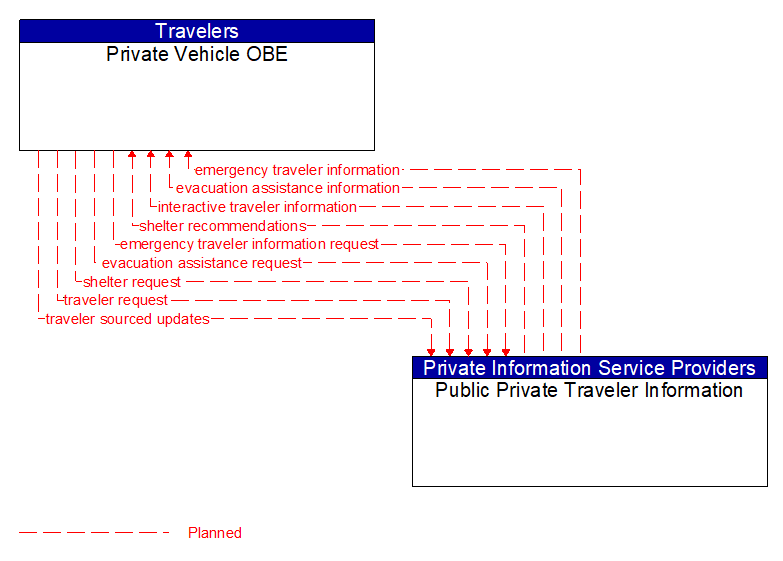Interface: Private Vehicle OBE - Public Private Traveler Information

Information Flow Definitions
emergency traveler information (Planned) Selected Comm Solution
Public notification of an emergency such as a natural or man–made disaster, civil emergency, or child abduction. This flow also includes evacuation information including evacuation instructions, evacuation zones, recommended evacuation times, tailored evacuation routes and destinations, traffic and road conditions along the evacuation routes, traveler services and shelter information, and reentry times and instructions.
emergency traveler information request (Planned) Selected Comm Solution
Request for alerts, evacuation information, and other emergency information provided to the traveling public.
evacuation assistance information (Planned) Selected Comm Solution
Information on evacuation resources including self–evacuation options, anticipated pickup time and location if a transportation asset is to be deployed, destination shelter, and supporting information on what to bring, estimated reentry date/time.
evacuation assistance request (Planned) Selected Comm Solution
A request for evacuation assistance, which may be registered in advance or issued during an evacuation. It specifies the location, number of people that need to be evacuated, and any special needs/requirements.
interactive traveler information (Planned) Selected Comm Solution
Traveler information provided in response to a traveler request. The provided information includes traffic and road conditions, advisories, incidents, restrictions, payment information, transit services, parking information, weather information, and other travel–related data updates and confirmations.
shelter recommendations (Planned) Selected Comm Solution
Recommendation identifying the shelter or shelters best suited to the requestor. Hotels/motels may also be included as potential sheltering options. This flow may also include shelter assignments/reservations.
shelter request (Planned) Selected Comm Solution
A request for shelter information, recommendations, or assignment/reservation. Information provided my include name, current location, number of people in the group, additional requirements (e.g., evacuating with pets, needed medical support).
traveler request (Planned) Selected Comm Solution
A request for traveler information including traffic, transit, toll, parking, road weather conditions, event, and passenger rail information. The request identifies the type of information, the area of interest, parameters that are used to prioritize or filter the returned information, and sorting preferences.
traveler sourced updates (Planned) Selected Comm Solution
Traveler posts on traffic and road conditions, parking availability, transit services, traveler services, shelter information, hazards, debris, obstacles, and other real–time crowd–sourced data that may be shared with other travelers.